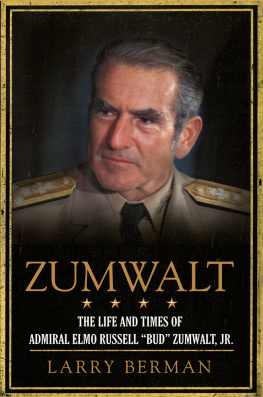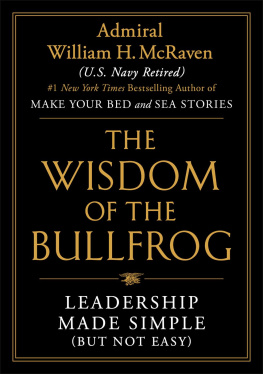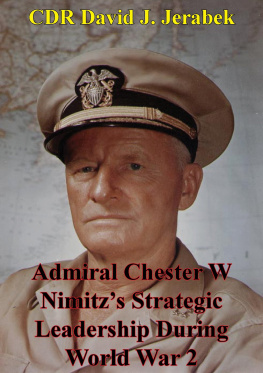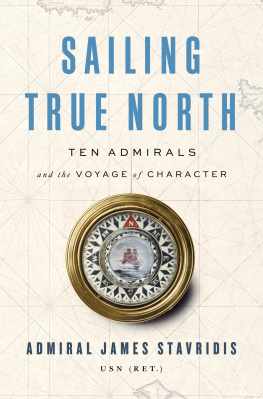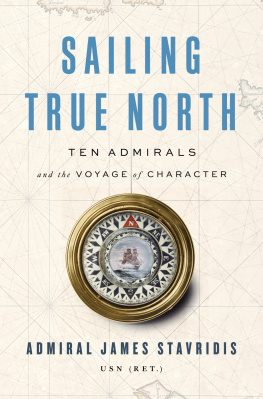
Z UMWALT
The Life and Times of Admiral Elmo Russell Bud Zumwalt, Jr.
L ARRY B ERMAN

For my grandchildren, Isabel and Ian
Father of the Modern Navy will remain a unique epitaph to this man.
VICE ADMIRAL EARL FRANK REX RECTANUS IN A LETTER TO MOUZA ZUMWALT, JANUARY 10, 2000
C ONTENTS

I have been called controversial. I am glad that this is so because the requirement was to be as Robert Frost phrased it, And I have miles to go before I sleep.
With its copper-clad dome soaring two hundred feet above the ground, the historic chapel at the center of the yard can be seen from every approach to the United States Naval Academy in Annapolis. Built upon a cornerstone laid in June 1904 by the legendary Admiral of the Navy George Dewey, the chapel serves as the navys cathedral. A below-ground crypt holds the remains of John Paul Jones, the great naval leader of the American Revolution who gave the navy its earliest traditions of heroism and victory.
On the cold and overcast morning of January 10, 2000, over two thousand people filled the wooden pews of the chapel to bid farewell to Admiral Elmo Russell Zumwalt, Jr., whose life exemplified the words etched above the massive bronze entrance doors: NON SIBI SED PATRIAE , meaning Not for self but for country .
Bud Zumwalt, which is what just about everyone called him throughout his life, is remembered as a trailblazer who reformed the navy and as a champion of the men and women who served in it. He was the iconoclastic admiral who brought a navy drifting toward the shoals back into the channel of the twentieth century and prepared it for the new millennium. Bud Zumwalt forced the navy to think more deeply and objectively about things that should have been self-evident. By doing so, he became a sailors admiral, often referred to as Zorro, fighting for the rights of oppressed navy men and women. In 1970 he landed on the cover of Time magazine, which called the charismatic chief of naval operations (CNO) the Navys most popular leader since World War II.
The press quickly dubbed it the Mod-Squad Navy led by its psychedelic admiral. Sailors began sporting longer hair, beards, and sideburns. The infamous Z-grams attempted to meld the traditions of navy service with the needs of a nation in turmoil and a culture in transition. The navy was never the same. Beer dispensers were allowed in enlisted mens barracks, acid rock blared from service clubs, and women were going to sea. Traditionalists, mostly white, retired admirals, ridiculed the reforms as the Three Bsbeer, beards, and broads, deriding Zumwaltism for undoing navy discipline and leading to mutinies at sea.
Bud Zumwalt requested that his funeral be held at the Naval Academy, the place of many memories and milestones in his distinguished career. At Bancroft Hall, his plebe class had been sworn in as midshipmen, taking their oath under Commodore Perrys flag and Captain Lawrences words Dont Give Up the Ship. Graduating cum laude with the wartime class of 1943, the young ensign made his way to the Pacific, soon reporting to the destroyer USS Robinson , where his performance as head of the ships Combat Information Center during night torpedo attacks in the historic Battle of Leyte Gulf earned him the Bronze Star for valor in combat. It was the start of a career characterized by service to the nation and commitment to the welfare of those under his command.
Inside the chapel were the countrys highest dignitaries, the most prominent being the nations commander in chief President William Jefferson Clinton and First Lady Hillary Rodham Clinton. Two years earlier, in the East Room of the White House, the president had presented his dear friend with the nations highest civilian honor, the Presidential Medal of Freedom. At the ceremony, Clinton joked that these days, Elmo Bud Zumwalt introduces himself as a former sailor. Thats sort of like calling Henry Ford a former car salesman. When the laughter subsided, the president described Zumwalt as a great patriot and one of the greatest models of integrity and leadership in genuine humanity our nation has ever produced. The Medal of Freedom citation provided the most appropriate accolade: In both wartime and peacetime, Elmo Zumwalt has exemplified the ideal of service to our nation. A distinguished veteran of World War II and Korea, he served as Commander of U.S. Naval Forces in Vietnam and rose to become the Navys youngest chief of Naval Operations in 1970. As CNO, he worked vigorously to improve our sailors quality of life and devoted himself to eliminating discrimination in the Navy. In a life touched by tragedy, he became a great champion of veterans afflicted by ailments related to service in Vietnam. For his dedication, valor, and compassion, we salute Bud Zumwalt.
Bud Zumwalt and Bill Clinton first met when Governor Clinton consulted Zumwalt on the disposal of Agent Orange barrels in his home state of Arkansas. After Clintons election, Bud sought the presidents support for Vietnam-era veterans who had been exposed to Agent Orange, a topic whose importance Clinton grasped immediately. The president designated Robert G. Bell, a member of the National Security Council staff, to liaise directly with Zumwalt on all Agent Orange issues.
The president sought Buds advice on normalizing relations with Vietnam, strategic-arms agreements, and cabinet-level appointments. In 1995 Clinton appointed Bud to the presidents Foreign Intelligence Advisory Board, which focused on threats to our nations national security involving weapons of mass destruction, biological, chemical, and nuclear. Bud and the president worked closely together to pass the Chemical Weapons Convention. Zumwalt then served as an honorary member of the Veterans for Clinton/Gore National Steering Committee in 1996.
The unique chemistry between Bud Zumwalt and Bill Clinton took root at the annual Renaissance Weekends in Hilton Head, South Carolina, and one Renaissance gathering forever solidified their friendship.
An early arrival at the chapel was Buds younger brother Jim. Neither man could have asked for a more caring or loving sibling, although Jims strong antiwar views and liberal leanings often tested the patience of his more conservatively inclined brother. A July 1968 personal letter of congratulations on the occasion of Buds promotion to the rank of vice admiral and new assignment as head of the Brown Water Navy in Vietnam expressed Jims heartfelt sentiments: In spite of all the political differences, I have never stopped loving you as a brother, nor have I questioned your integrity or sincerity. If ever a military figure had compassion, you have it. Jim was especially proud that Bud was beloved by enlisted men, women, and minorities.
After he passed through a metal detector, secret service agents ushered Jim into a private vestibule for family members. With Bud gone, Jim and Saralee Crowe were the surviving children raised by two country doctors on the avenue of the sycamores in Tulare, California. Saralee was the eldest, followed by Elmo, Jr.; Bruce Craig; and James Gregory. As Saralee embraced Jim, her mind raced through a lifetime of memories that included Crowe family visits to Mare Island, where after dinner at the officers club, they listened to Bud make Tarzan calls from a tree house and went to sleep in a sun-heated Quonset hut. Her favorite memory was the time Bud drove across the country to visit the Crowes at Wawona Lodge in Yosemite. Bud arrived at the gate exhausted and out of money, but the Ranger would not allow any servicemen to enter the park free who were not in uniform. Bud got his suitcase from the car and changed right there in front of God and everybody.
Next page
